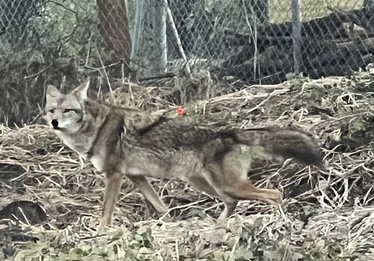Is my overgrown yard attracting coyotes?
What about the food I left out on the porch for my outdoor cat?
These are the questions San Francisco’s Animal Care and Control would like residents and homeowners to ask themselves during what is known as exploring season for the city’s urban coyote population.
The normal cycle of urban coyote life begins with mating season in the winter with pups born during the denning season in the spring, according to Animal Care and Control spokesperson Deb Campbell. When the pups emerge during the fall, they disperse and look for their own space.
“This is the season where we see the most activity,” Campbell said. “People notice them coming and going, sometimes during the day. Just because you may see coyotes during the day doesn’t mean that they are sick or rabid. It is just that they are acclimated to city life.”
RELATED: 4 Myths About SF Coyotes, Debunked
Campbell said Animal Care and Control, the Presidio Trust and the San Francisco Recreation and Park Department gather each month to review sighting reports to track movement of coyotes in areas like Golden Gate Park, Fort Mason or Bernal Heights.
“What we know from years of doing this is that there are patterns with coyote visibility,” she said, adding that it is the point in the year where dispersal season ends and breeding season begins. So coyotes can be more visible in the fall through early winter.”
In recent days, coyotes have been seen in some unusual places due to their youth and inexperience maneuvering in an urban environment, according to Campbell.
“On Thursday, we had one running on Interstate 280,” she recalled. “We had [California Highway Patrol] and the police help us block off 280 so that the coyote could get off the freeway.”
In another case, a coyote jumped from a pier into the San Francisco Bay, prompting a water rescue by animal control officers, she added.
Recently, a plethora of posts on sites, such as NextDoor, have sprung up online documenting coyote interactions between the species and San Franciscans.
According to the Recreation and Park Department, there have been 30 coyote sightings in the city so far in 2023—mainly concentrated in and around Golden Gate Park and the Presidio.
Although coyotes tend to remain in the more wooded areas of San Francisco, Campbell said, illegal wildlife feeding can draw the species into neighborhoods.
“There’s a lot of illegal wildlife feeding that goes on in San Francisco,” she said. “People will feed them cat food or hand out sandwiches, which is really bad. It invites them to a neighborhood to look for food and handouts. It disrupts the natural cycle.”
Campbell also encouraged residents to keep their yards maintained, keep cats indoors and dogs on a leash unless in a designated non-leash area.
“So many conflicts and heartbreaking things can be avoided by just keeping your dog on the leash,” she said, adding that young coyotes often will follow people with dogs to ensure they leave their territory. “We always tell people to just always walk slowly away and leave the area.”
If someone sees a coyote, according to Campbell, they should report their sighting and upload any pictures to the Animal Care and Control website, which helps with research related to coyote movement in San Francisco.
If someone encounters an emergency situation involving coyotes—such as injuries sustained during interactions, if the coyote has been injured or it appears sick—they should contact the Animal Care and Control emergency phone number at 415-544-9400 and an animal control officer will respond, she added.
The agency also offers a yard assessment for residents who may experience frequent coyote visits to their homes.
“You may have a beautiful koi pond, but the coyotes look at that as a water fountain,” Campbell said. “We will look and see if there is anything we could recommend for residents to cover, stop, don’t do or remove. Our officers are very well versed in these things.”
